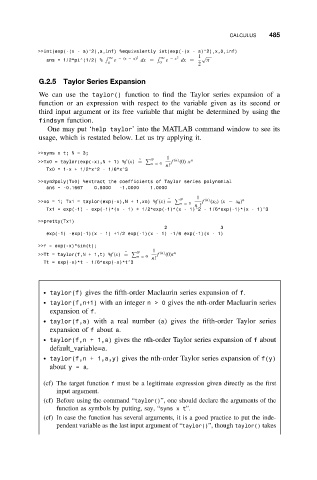Page 496 - Applied Numerical Methods Using MATLAB
P. 496
CALCULUS 485
>>int(exp(-(x - a)^2),a,inf) %equivalently int(exp(-(x - a)^2),x,0,inf)
∞ − (x − a) 2 ∞ − x 2 1 √
ans = 1/2*pi^(1/2) % e dx = e dx = π
a 0
2
G.2.5 Taylor Series Expansion
We can use the taylor() function to find the Taylor series expansion of a
function or an expression with respect to the variable given as its second or
third input argument or its free variable that might be determined by using the
findsym function.
One may put ‘help taylor’ into the MATLAB command window to see its
usage, which is restated below. Let us try applying it.
>>syms x t;N=3;
1
N
>>Tx0 = taylor(exp(-x),N + 1) %f (x) ˜ = n = 0 n! f (n) (0) x n
Tx0 = 1-x + 1/2*x^2 - 1/6*x^3
>>sym2poly(Tx0) %extract the coefficients of Taylor series polynomial
ans = -0.1667 0.5000 -1.0000 1.0000
1
N
>>xo = 1; Tx1 = taylor(exp(-x),N + 1,xo) %f (x) ˜ = f (n) (x 0 )(x − x 0 ) n
n = 0
n !
Tx1 = exp(-1) - exp(-1)*(x - 1) + 1/2*exp(-1)*(x - 1)^2 - 1/6*exp(-1)*(x - 1)^3
>>pretty(Tx1)
2 3
exp(-1) -exp(-1)(x - 1) +1/2 exp(-1)(x - 1) -1/6 exp(-1)(x - 1)
>>f = exp(-x)*sin(t);
1
N
>>Tt = taylor(f,N + 1,t) %f (x) ˜ = n = 0 f (n) (0)t n
Tt = exp(-x)*t - 1/6*exp(-x)*t^3 n!
ž taylor(f) gives the fifth-order Maclaurin series expansion of f.
ž taylor(f,n+1) with an integer n>0 gives the nth-order Maclaurin series
expansion of f.
ž taylor(f,a) with a real number (a) gives the fifth-order Taylor series
expansion of f about a.
ž taylor(f,n + 1,a) gives the nth-order Taylor series expansion of f about
default variable=a.
ž taylor(f,n + 1,a,y) gives the nth-order Taylor series expansion of f(y)
about y=a.
(cf) The target function f must be a legitimate expression given directly as the first
input argument.
(cf) Before using the command “taylor()”, one should declare the arguments of the
function as symbols by putting, say, “syms x t”.
(cf) In case the function has several arguments, it is a good practice to put the inde-
pendent variable as the last input argument of “taylor()”, though taylor() takes

